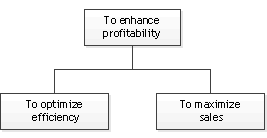The most important thing is to identify the next-most important thing. Read why and how below. It starts with defining your objectives …
Please check for future installments in our video series on this topic.
A Structured Approach to Securing the Benefits of Modern Technology
Cooperation drives success. Cooperation is the main focus of enterprise, where incorporation is used to create entities of cooperating individuals. There are other terms for cooperation: teamwork, being on the same page, marching to the same drummer, having common interests, shared vision, unity of purpose, etc. Cooperation can be pursued by various means, including force of personality, intimidation, love, logic, and mutual agreement.
On this page, we describe a foundation for cooperation that relies on logic and mutual agreement. It has its roots in software engineering and US military methodology. OOI™ does not replace creativity or intelligence, but is a useful tool to organize thoughts and structure improvements. It provides a dynamic framework, subject to revision, guided by good metrics and quality data, decidedly not rigid nor doctrinaire. We understand the Voltaire aphorism that “The perfect is often an enemy of the good”. We also observe the counterexample expressed in the poem by e. e. cummings, “let’s live suddenly without thinking”. Although living suddenly is often celebrated, it and not thinking do not fit with information systems work, nor do distractions and glitz.
OOI™ can be “A Useful Technique” to manage complexity and promote simplicity, which are key to understanding and then achieving goals and objectives. Business and organization leaders may already know exactly their goals and objectives, in which case OOI™ is useful for converting their ideas into executable plans.
Our process begins by defining those things that are most important to a business or organization, which we call objectives.
Objectives are general statements of purpose or desired ends. If you believe that “the ends” should justify the “the means” (or that it is important to have a destination before starting a trip) you must first understand these “ends”. To achieve this understanding, we formally define these ends and label them objectives. Examples of objectives are success, profitability, efficiency, effectiveness, and stability. There are also more qualitative objectives like respect, influence, gratification, and contentment. As an example, the lead objective of Automation Consultants is “To improve the lives and promote the success of our clients”.
To achieve objectives we establish goals. Goals are specific targets, with associated metrics, deadlines, and resource budgets. Goals always have quantified metrics, like football scores.
Please be aware that there are differing conventions on these terms. Some refer to the top-level purposes or desired overall ends as goals, with underlying objectives servicing them. If you prefer this convention, please mentally swap goals and objectives as you continue reading. Our convention stems from second-hand gleanings of Operations Research instruction at the Naval Postgraduate School and the book “A Methodology for Systems Engineering” by Arthur Hall. If you focus on business planning or marketing, see “The Marketing Plan” by William Cohen.
Objective-Oriented Improvement™
OOI™ is our way of determining and agreeing on what a business’s or organization’s objectives are, and then providing a structured plan to accomplish them. Although we mainly apply it to business, it works for all organizations and endeavors.
The first step in OOI™ is to create an objective tree, which reflects the fact that some objectives are more important and some depend on others. For example, profitability, served by efficiency and sales volume, defines a simple objective tree with two branches.
 After an objective tree is initially defined, documented, and discussed, it is important to establish an ongoing process so that suggestions and elaborations can be incorporated, and agreement confirmed as the tree grows and is adjusted. Some businesses and organizations may not quickly identify higher-order objectives, but readily express lower-order ones like “To have staff proficient with accounting software”. Others may express points of pain, from which we can derive objectives, such as, “I get too many complaints”. Objectives can be collected at any level, but high-order objectives must eventually be identified and understood. As objectives are defined, it becomes clear how they relate. For example, if we start with “To optimize efficiency” as above, and ask the question why, we would answer with a higher-order objective, namely “To enhance profitability”. Similarly, if we begin with “To enhance profitability” and ask the question how, we would answer with the lower-order objectives “To optimize efficiency” and “To maximize sales”.
After an objective tree is initially defined, documented, and discussed, it is important to establish an ongoing process so that suggestions and elaborations can be incorporated, and agreement confirmed as the tree grows and is adjusted. Some businesses and organizations may not quickly identify higher-order objectives, but readily express lower-order ones like “To have staff proficient with accounting software”. Others may express points of pain, from which we can derive objectives, such as, “I get too many complaints”. Objectives can be collected at any level, but high-order objectives must eventually be identified and understood. As objectives are defined, it becomes clear how they relate. For example, if we start with “To optimize efficiency” as above, and ask the question why, we would answer with a higher-order objective, namely “To enhance profitability”. Similarly, if we begin with “To enhance profitability” and ask the question how, we would answer with the lower-order objectives “To optimize efficiency” and “To maximize sales”.
After objectives are established, the next step is to establish goals. Goals can be viewed as specific objectives with time and other resource constraints. “Provide marketing feedback of number of units sold with profit derived by next February 29”, is an example of a goal. It is important that goals include specific metrics, defined and documented with a clear criterion for success so that the attainment of a goal will not be questioned (or gamed).
Once initial objectives are named and goals set, the next step is to devise strategies to meet these goals. It is possible for one strategy to service more than one goal and, of course, more than one strategy may be required to meet a particular goal. For example, the strategy of collecting all appropriate sales data into one database may serve our February 29 goal above, and also other goals. Formulating strategies benefits from creativity.
The last step in our process is to formulate tasks to execute each strategy. A task can serve more than one strategy, but this is not common. A task is a specific action, such as “Install CRM” or “Train Users to collect all appropriate sales data”. Some refer to these steps as tactics.
The most critical tasks focus on improving performance through use-case analysis, Unified Modeling Language, and work-flow optimization.
We can provide examples of common objectives, strategies, and tasking, but prefer to first collect unbiased ideas so we do not overlook important insights. One important point is that as an objective-oriented structure is adjusted and executed, any part may change. In our original example, for instance, we may at some point discover that increasing sales volume does not serve profitability. Such a change usually spawns other changes that radiate down (and sometimes up) the tree to maintain consistency, which can lead to changes in goals, strategies, and tasks.
OOI™, in our practice
Below are attributes of an OOI™ candidate that enable us to meet our objective of improving the business life and promoting the success of our clients.
- Interested in improving their business or organization
- Willing to invest sufficient time and resources to define their objectives and goals
- Having sufficient discipline to implement changes, measure their effects, and institute improvements
- Having sufficient objectivity to judge the results of change and the creativity to design improvements
You can find much discussion and many images by searching on <business “objective tree” goal strategy>. Many methodologies similar to OOI™ are practiced in the private sector, government, and the military, and in Project Management. Our formulation has been refined over a number of decades to benefit our clients.
Because it is difficult to measure the effects of change with flawed data, a crucial ally of OOI™ is information quality. This topic can be explored in depth through professional organizations like The International Standard Organization, for an example see https://www.iso.org/committee/54158.html.
Our example — Here are the top objectives in the Automation Consultants objective tree, we have three of equal importance. We are happy to discuss the goals, strategies, and tactics we have adopted to serve these objectives.
I. Objective: To improve the lives and business success of our clients
II. Objective: To generate sufficient revenue to sustain ACinc operations and support growth
III. Objective: To showcase ACinc as an example of good business practices and systems

